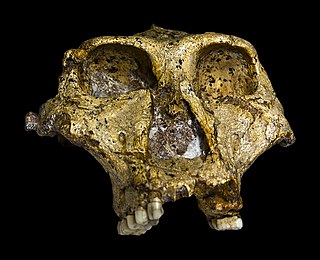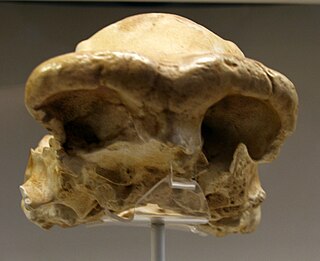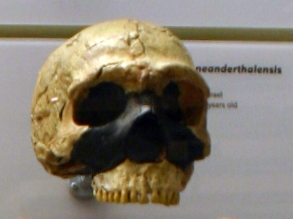Fraudulent photograph
An image has circulated across the Internet which is purported to be of a Boskopoid skull. However, this image in actuality depicts the skull of a hydrocephalus patient. [11]

The Boskop Man is an anatomically modern human fossil of the Middle Stone Age (Late Pleistocene) discovered in 1913 in South Africa. [1] The fossil was at first described as Homo capensis and considered a separate human species by Broom (1918), [2] but by the 1970s this "Boskopoid" type was widely recognized as representative of the modern Khoisan populations. [3]
Most theories regarding a "Boskopoid" type were based on the eponymous Boskop cranium, which was found in 1913 by two Afrikaner farmers. They offered it to Frederick William FitzSimons for examination and further research. Many similar skulls were subsequently discovered by paleontologists such as Robert Broom, William Pycraft and Raymond Dart.
The original skull was incomplete consisting of frontal and parietal bones, with a partial occiput, one temporal and a fragment of mandible.
Fossils of similar type are known from Tsitsikamma (1921), Matjes River (1934), Fish Hoek and Springbok Flats, [4] Skhul, Qafzeh, Border Cave, Brno, Tuinplaas, and other locations. [5]
The Boskop Man fossils are notable for their unusually large cranial capacities, with reported cranial-capacity ranges between 1,700 and 2,000 cm3. [6] It has been concluded that whenever archaeologists uncovered Hottentot skulls that possessed an especially large cranial capacity, they likely labeled them as Boskopoid skulls and as such, the Boskopoid skull type was simply an artifact of their biases. [7] For instance, when James Henderson Sutherland Gear identified skulls recovered from Tsitsikamma as Boskopoid, he simply compared them with the original Boskop Man skull without comparing them with any modern African skulls and as a result, failed to realize they were Hottentot skulls. [8]
In the book Big Brain: The Origins and Future of Human Intelligence (2008) by neurologists Gary Lynch and Richard Granger, it was claimed the large brain size in Boskop individuals might be indicative of particularly high general intelligence. Anthropologist John Hawks harshly criticized the depiction of the Boskop fossils in the book and in the book's review article in Discover magazine. [6] [9] [10]
An image has circulated across the Internet which is purported to be of a Boskopoid skull. However, this image in actuality depicts the skull of a hydrocephalus patient. [11]


Homo habilis is an extinct species of archaic human from the Early Pleistocene of East and South Africa about 2.8 million years ago to 1.65 million years ago (mya). Upon species description in 1964, H. habilis was highly contested, with many researchers recommending it be synonymised with Australopithecus africanus, the only other early hominin known at the time, but H. habilis received more recognition as time went on and more relevant discoveries were made. By the 1980s, H. habilis was proposed to have been a human ancestor, directly evolving into Homo erectus which directly led to modern humans. This viewpoint is now debated. Several specimens with insecure species identification were assigned to H. habilis, leading to arguments for splitting, namely into "H. rudolfensis" and "H. gautengensis" of which only the former has received wide support.

Australopithecus is a genus of early hominins that existed in Africa during the Pliocene and Early Pleistocene. The genera Homo, Paranthropus, and Kenyanthropus evolved from some Australopithecus species. Australopithecus is a member of the subtribe Australopithecina, which sometimes also includes Ardipithecus, though the term "australopithecine" is sometimes used to refer only to members of Australopithecus. Species include A. garhi, A. africanus, A. sediba, A. afarensis, A. anamensis, A. bahrelghazali and A. deyiremeda. Debate exists as to whether some Australopithecus species should be reclassified into new genera, or if Paranthropus and Kenyanthropus are synonymous with Australopithecus, in part because of the taxonomic inconsistency.

Meganthropus is an extinct genus of non-hominin hominid ape, known from the Pleistocene of Indonesia. It is known from a series of large jaw and skull fragments found at the Sangiran site near Surakarta in Central Java, Indonesia, alongside several isolated teeth. The genus has a long and convoluted taxonomic history. The original fossils were ascribed to a new species, Meganthropus palaeojavanicus, and for a long time was considered invalid, with the genus name being used as an informal name for the fossils.
Paleoanthropology or paleo-anthropology is a branch of paleontology and anthropology which seeks to understand the early development of anatomically modern humans, a process known as hominization, through the reconstruction of evolutionary kinship lines within the family Hominidae, working from biological evidence and cultural evidence.

Sterkfontein is a set of limestone caves of special interest in paleoanthropology located in Gauteng province, about 40 kilometres (25 mi) northwest of Johannesburg, South Africa in the Muldersdrift area close to the town of Krugersdorp. The archaeological sites of Swartkrans and Kromdraai are in the same area. Sterkfontein is a South African National Heritage Site and was also declared a World Heritage Site in 2000. The area in which it is situated is known as the Cradle of Humankind. The Sterkfontein Caves are also home to numerous wild African species including Belonogaster petiolata, a wasp species of which there is a large nesting presence.

Australopithecus africanus is an extinct species of australopithecine which lived between about 3.3 and 2.1 million years ago in the Late Pliocene to Early Pleistocene of South Africa. The species has been recovered from Taung, Sterkfontein, Makapansgat, and Gladysvale. The first specimen, the Taung child, was described by anatomist Raymond Dart in 1924, and was the first early hominin found. However, its closer relations to humans than to other apes would not become widely accepted until the middle of the century because most had believed humans evolved outside of Africa. It is unclear how A. africanus relates to other hominins, being variously placed as ancestral to Homo and Paranthropus, to just Paranthropus, or to just P. robustus. The specimen "Little Foot" is the most completely preserved early hominin, with 90% of the skeleton intact, and the oldest South African australopith. However, it is controversially suggested that it and similar specimens be split off into "A. prometheus".

Homo rhodesiensis is the species name proposed by Arthur Smith Woodward (1921) to classify Kabwe 1, a Middle Stone Age fossil recovered from Broken Hill mine in Kabwe, Northern Rhodesia. In 2020, the skull was dated to 324,000 to 274,000 years ago. Other similar older specimens also exist.

An occipital bun, also called an occipital spur, occipital knob, chignon hook or inion hook, is a prominent bulge or projection of the occipital bone at the back of the skull. It is important in scientific descriptions of classic Neanderthal crania. It is found among archaic Homo species, as well as Upper Pleistocene Homo sapiens and present-day human populations.

The Taung Child is the fossilised skull of a young Australopithecus africanus. It was discovered in 1924 by quarrymen working for the Northern Lime Company in Taung, South Africa. Raymond Dart described it as a new species in the journal Nature in 1925.

Paranthropus robustus is a species of robust australopithecine from the Early and possibly Middle Pleistocene of the Cradle of Humankind, South Africa, about 2.27 to 0.87 million years ago. It has been identified in Kromdraai, Swartkrans, Sterkfontein, Gondolin, Cooper's, and Drimolen Caves. Discovered in 1938, it was among the first early hominins described, and became the type species for the genus Paranthropus. However, it has been argued by some that Paranthropus is an invalid grouping and synonymous with Australopithecus, so the species is also often classified as Australopithecus robustus.

Paranthropus boisei is a species of australopithecine from the Early Pleistocene of East Africa about 2.5 to 1.15 million years ago. The holotype specimen, OH 5, was discovered by palaeoanthropologist Mary Leakey in 1959 at Olduvai Gorge, Tanzania and described by her husband Louis a month later. It was originally placed into its own genus as "Zinjanthropus boisei", but is now relegated to Paranthropus along with other robust australopithecines. However, it is also argued that Paranthropus is an invalid grouping and synonymous with Australopithecus, so the species is also often classified as Australopithecus boisei.

Sinanthropus is an archaic genus in the scientific classification system to which the early hominid fossils of Peking man, Lantian Man, Nanjing Man, and Yuanmou Man were once assigned. All of them have now been reclassified as Homo erectus, and the genus Sinanthropus is disused. Beginning in the year 1928 to the year 1937, 14 fragmented skulls belonging to the hominids were found in various locations in China. Peking and Chou K’ou-tien are two notable places with fossils found. It has been noted by researchers that it is likely that the found fragmented skulls were brought to the cave after being severed from the bodies they belonged to. This is very likely, because most of the found pieces are teeth and jaws. Some skulls are missing large parts which indicates separation before they were fossilized, not the loss of pieces due to fossilization process.
Human taxonomy is the classification of the human species within zoological taxonomy. The systematic genus, Homo, is designed to include both anatomically modern humans and extinct varieties of archaic humans. Current humans have been designated as subspecies Homo sapiens sapiens, differentiated, according to some, from the direct ancestor, Homo sapiens idaltu.

OH 7, also nicknamed "Johnny's Child", is the type specimen of Homo habilis. The fossils were discovered on November 4, 1960 in Olduvai Gorge, Tanzania, by Jonathan and Mary Leakey. The remains are dated to approximately 1.75 million years, and consist of fragmented parts of a lower mandible, an isolated maxillary molar, two parietal bones, and twenty-one finger, hand, and wrist bones.

KNM ER 1813 is a skull of the species Homo habilis. It was discovered in Koobi Fora, Kenya by Kamoya Kimeu in 1973, and is estimated to be 1.9 million years old.

KNM ER 406 is an almost complete fossilized skull of the species Paranthropus boisei. It was discovered in Koobi Fora, Kenya by Richard Leakey and H. Mutua in 1969. This species is grouped with the Australopitecine genus, Paranthropus boisei because of the robusticity of the skull and the prominent characteristics. This species was found well preserved with a complete cranium but lacking dentition. He was known for his robust cranial features that showed the signs of adaptation of the ecological niches. The big chewing muscles attached to the sagittal crest are traits of this adaptation.

Nanjing Man is a specimen of Homo erectus found in China. Large fragments of one male and one female skull and a molar tooth of were discovered in 1993 in Hulu Cave on the Tangshan (汤山) hills in Jiangning District, Nanjing. The specimens were found in the Hulu limestone cave at a depth of 60–97 cm by Liu Luhong, a local worker. Dating the fossils yielded an estimated age of 580,000 to 620,000 years old.

Frederick William FitzSimons, was an Irish-born South African naturalist, noted as a herpetologist for his research on snakes and their venom, and on the commercial production of anti-venom.

Olduvai Hominid number 9, known as the Chellean Man, is a fossilized skull cap of an early hominin, found in LLK II, Olduvai Gorge by Louis S. B. Leakey in 1960. It is believed to be ca. 1.4 million years old. Its cranial capacity is estimated at than 1067 cm3, the largest value among all known African Homo erectus specimens. OH 9 is significant because the features it carried and its correlation to the species classification it resides in.

Amud 1 is a nearly complete but poorly preserved adult Southwest Asian Neanderthal skeleton thought to be about 55,000 years old. It was discovered at Amud in Israel by Hisashi Suzuki in July 1961, who described it as male. With an estimated height of 1.78 m, it is considerably taller than any other known Neanderthal, and its skull has by far the largest cranial capacity of any human skull in the fossil record. According to Ralph Holloway, this makes it one of the most famous Neanderthal specimens.